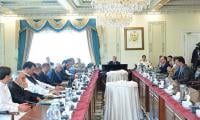The writer is an independent education researcher and consultant. She has a PhD in Education from Michigan State University.
The National Curriculum Council (NCC) claims that the new model textbooks it had developed for the Single National Curriculum (SNC) epitomize state-of-the-art in pedagogy.
However, private school owners and publishers that have, informally, seen excerpts of these model textbooks describe them as ordinary and unimaginative. Some described them as shoddy copy-and-paste jobs as bad as the books they are replacing. Its proponents continue to defend the SNC as being just a minimum standard. The innovative teaching approaches the SNC promised are limited by the lack of capacity of what the majority of public-school teachers are able to deliver in classrooms. No wonder then that the minimality of the SNC is reflected in the mediocrity of its model textbooks.
Since the SNC was released in the summer, several well-known private schools have conducted internal mapping studies, comparing the SNC with their own primary school curricula. Here are some of their findings.
Take English for example: One school owner explained to me her very systematic approach to teaching English as a first language (as opposed to many private schools that teach it as a second language). Their entire curriculum is structured in a way that allows children (from variable backgrounds) to start thinking, writing, and speaking in English from day one). In order to do that, they follow the systematic phonics system, among several other things, to teach English at the primary level. Children learn the 44 sounds used in the English language to learn to read and write any text.
Further down the line, students are taught word roots and their origins in Latin, French, and other languages, which allows them to spell new words as well as understand their meaning and usage. Grammar (nouns, adjectives, adverbial phrases) is taught by exposing students to texts that demonstrate their use, sometimes in subjects other than English, rather than memorizing dictionary definitions. In contrast, based on the excerpts of English textbooks seen so far, the model textbooks will rely on the traditional approach to teaching and reading words, that is akin to rote learning.
Similarly, all private schools have been asked to teach ‘General Knowledge’ in Urdu in grades 1 and 2 before the subject is split into Science and Social Studies at grade 3. Most middle and top-tier private schools teach Science as a separate subject starting at the KG level. These schools being made to switch to the government model will have to dilute either their Social Studies or their Science curriculum to accommodate the new requirement, not to mention find and train teachers that can switch to teaching these subjects in Urdu.
The NCC labeling its minimum learning standard as a curriculum is misleading. Even many officials in public education departments today do not know the difference between a textbook, a syllabus, and a curriculum, and that is the issue. Many private school owners do not understand these differences either. Those who do, know that imposing one book in all schools, like Punjab is doing, will throw into disarray their entire approach to teaching and learning developed over years.
The government is insistent that publishers and private schools prove that the textbooks they seek NOCs for are aligned with the SNC at each grade. This requirement does not acknowledge that many good private schools have different grade progression levels in the early years – nursery at age 3, Kindergarten at age 4, prep-1 at age 5 and grade 1 at age 6.
The SNC has been developed on the rigid assumptions of the public-school model – ‘Katchi’ (equivalent of KG) before entering grade 1. This way children at some private schools, even if they do not get an academic head start at home or preschool, are already performing at public school equivalent of grade 1 level long before their public-school counterparts. In other words, a category of private schools is covering grade 1 learning outcomes at prep-1 level. If they are forced to align grade 1 books with the SNC grade 1, they will end up diluting their syllabus.
The learning achievements of children in different schools (including public) vary widely. Yet, in Punjab the government is adamant on forcing its textbooks made to meet only the minimum learning standards that is the SNC and is designed with the abilities of the lowest common denominator among public school teachers in mind.
Even parents of school-going children have finally begun paying attention. A petition by concerned parents that began circulating last month demands a slower, grade-by-grade roll-out of the SNC, rather than the stage-by-stage roll-out (primary, middle, high) currently announced.
However, here too there are issues: first, parents seem to only be interested in ‘what happens to my child’. So, parents signing off on petitions demanding grade-by-grade roll out seem to be counting on their children outrunning the SNC, others be damned. Second, parents do not understand the full repercussion of even a grade wise roll out as explained earlier. It will drag down the quality of education at better performing schools and by the time a child completes the primary level, she will have fallen behind peers in other school systems. By the time these children complete middle school and reach high school, they will be well behind their local peers in provinces like Sindh (which is not adopting the SNC) and internationally but are preparing for the same standardized international examination systems.
This is a time, particularly for private school parents, to demand from schools to tell them exactly what it is that their children are learning, how their learning will be affected if government textbooks are adopted and, just as importantly, how the curriculum of their school differs from the curriculum taught at other schools. Why should a parent send their child to private school A versus private school B versus public school? What is the added value?
If the government insists on making the use of other textbooks by private schools more difficult, then the burden of proof that its model textbooks measure up to better performing private schools’ curricula rests on the NCC, not on private schools. The NCC, not schools, should be conducting the exercise of mapping its minimum learning standard to widely followed curricula. Instead, private schools are being made to jump through hoops.
If you asked today, none of the government departments are aware of the various curricula private schools teach and where SNC stands (in terms of coverage and quality) against them. To be able to answer such questions, departments need to understand the various examination systems, supplementary materials and other co-curricular activities used by private schools, which they lack.
The high-handed approach of some on the NCC was on display in a meeting early this year. It was announced as a consultation meeting but was described by participants as a reading of the riot act. People that tried to ask questions were publicly insulted and received a dressing down. At one point, the concerns aired by private school representatives were brushed aside with a statement along the lines of [Your schools have only 30,000 or 40,000 students and are not our concern.] Government departments lord it over private schools.
I must acknowledge though that, at least in the case of the federal government, while it is not backing down from the requirement for NOCs for alternative textbooks, the ministry is trying to simplify and speed up the process, albeit reactively. Time will tell whether that will be sufficient for the timely issuance of NOCs for alternative textbooks.
This entire academic year has seen great disruption, with the third wave of Covid-19 necessitating school closings, yet again. Instead of focusing on remediating learning losses and coming to the aid of struggling private schools, the government is adamant on experimenting even if it means delaying the start of the next school year until August (because textbooks are not available) and squeezing it into just seven months.
Every major study over the last two decades that compared students’ learning achievements in public and private schools in Pakistan has yielded a consistent picture: On average, private schools outperform public schools. As much as it pains me to say, today the few Pakistani children that make it to the Harvards and Stanfords of the world are mostly graduates of private, not public schools. Instead of further burdening the part of the school sector that is performing better, relative to public schools, the government ought to focus its attention on its own schools.
Concluded
People stand in line up as election officials check their ballot papers during voting general election at a polling...
Women show their voter identity cards as they stand in a queue before casting their votes in Agartala. — PTIThe 18th...
Former prime minister Imran Khan. — Instagram/ imrankhan.ptiAn old saying has it that “when you dance with the...
Kashmiris in Indian illegally occupied Kashmir protesting against the Indian occupation as the forces of India looked...
A representational image showing residents walking at a wholesale market in Karachi. — AFP/FileOnce again there is...
A representational image showing late Pakistani human rights activist and Supreme Court lawyer Asma Jahangir. —...







